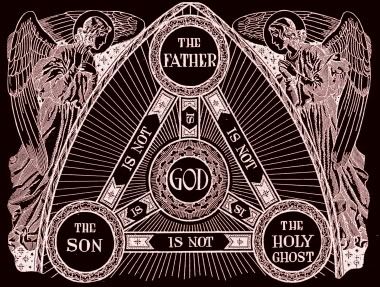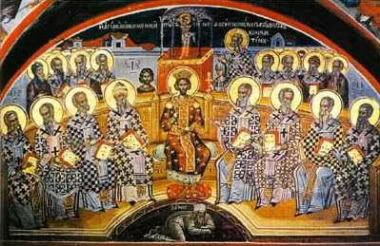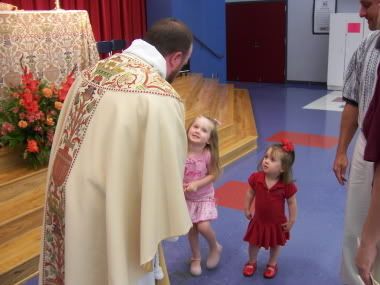
The classic Trinity diagram illustrating the relationships of the Persons of the Godhead.
You may listen to the sermon below by streaming audio or by download.
In the Name of the Father, and of the Son, and of the Holy Spirit. Amen.
The year was AD 325 and Christian bishops from all over the known world were gathered to take council for the Church in the resort town of Nicæa. They were called together by Constantine, the first Christian Emperor. Constantine’s political aim was to unite the empire and a key part of that strategy was to have a united Church—which was not a problem, until . . . a priest in Alexandria, Egypt named Arius started making a pronouncement from the pulpit that “there once was a time when Christ was not.”
Arius taught that there was not always a co-eternal Son of God. His doctrine was that Jesus is instead the most exalted of all God’s creatures, whom God anointed with the Spirit at baptism and adopted as a son. He said Jesus is inferior to God, that he is not “God the Son.” Arius asserted that Jesus is of a different substance, that is, that Jesus is not fully divine like the Father is.
The bishops had come to Nicæa to sort out the matter. At one point, the conversation got so heated that the saintly bishop of Myra in Turkey, named Nicholas (Santa Claus) who was known for his kindness and generosity, walked over to Arius and punched him out. The story goes that Nicholas was immediately deposed for such unruly conduct, but the council restored him the next day when several of the bishops had a dream about Nicholas being returned to his episcopal throne.

What would bring such indignation out of a gentle man like Nicholas? What made Ole’ St Nick pop his top? Why was he so upset? Did it really matter that much what Arius was saying? Indeed, it does matter, for sometimes even words can destroy souls. The Apostle Paul wrote to St. Timothy, “Watch your life and doctrine closely. Keep doing this, for by doing so, you save both yourself and those who listen to you” (1 Tim 4:16-17).
Each year, after Eastertide and the feast of Pentecost, we celebrate the principal feast we call Trinity Sunday. At the end of the incarnation and redemption cycles of the kalendar, we pause to give thanks and embrace our heritage of faith, our faith in and worship of the one true God. He is the Holy Trinity—God the Father, God the Son, and God the Holy Spirit.
In the older prayer books, there was a creed called the Quincunque vult, proscribed to be read on Trinity Sunday and at one of the minor prayer offices. This creed was named after St. Athanasius, one of the great defenders of the orthodox trinitarian faith, even through great cost and personal hardship. This “Athanasian Creed” is printed at the back of the Book of Common Prayer. It is a creed that mainly describes the doctrine of the Holy Trinity—and in careful, exacting detail.
Like the indignant bishop Nicholas at the Nicene council, it is very serious-minded. In the first line, we read: “Whosoever will be saved, before all things it is necessary that he hold the Catholic Faith. Which Faith everyone do keep whole and undefiled, without doubt, he shall perish everlastingly. And the Catholic Faith is this: that we worship one God in Trinity, and Trinity in Unity, neither confounding the Persons, nor dividing the Substance.”
Why does it matter so much? Why is it so important to keep the Catholic Faith whole, pure, and undefiled? Is it really so serious? Let us first realize that we know and identify God not just by name, but also by attributes. The same is true about other people; we know them both by name and by attributes. God has revealed to us certain things about himself, that reveal who he is. From the record of the Scriptures, we know that God is a person, that he is almighty and just, that he is also merciful, and that in the truest sense, God is love.
We read in the Bible that God has revealed himself as Father and that the Word and Spirit were involved in the act of creation. In the Scriptures we also learn that God has revealed his name—YHWH. God the Father names his only Son “Jesus,” which means “YHWH is salvation.”
In the New Testament, we learn that God so loved the world, that he gave his only begotten Son to us. The Word was incarnate and dwelt among us. Jesus is the perfect icon of the Father, full of grace and truth. Jesus fulfilled the law and bore our sins on the cross.
He rose victorious from the dead and Jesus offers us the same blessing of new life by sacramentally joining us to himself as his mystical Body through the new birth of Baptism and the Eucharistic feast. When Jesus rose into heaven, taking our humanity into heaven, he did not leave us comfortless, but sent the Holy Spirit into our hearts crying, “Abba, Father.”
We know who God is and what he has done by his own self-revelation. That’s why we can be confident that we are not worshiping a false God, an idol, or a god that is simply the projection of our own selves. It is only through the one, true, and living God that we find salvation.
Stressing this point, St. Paul wrote to the Galatians, “I am astonished that you are so quickly deserting him who called you into the grace of Christ and are turning to a different gospel. . . ." And Paul goes on to say, “Even if we, or an angel from heaven, should preach to you a gospel which is different from the one we have been preaching, let him be eternally condemned (anathema). As we have said before, so now I say again: If anyone is preaching to you a gospel contrary to the one you received, let him be eternally condemned” (Galatians 1:6-9). St. Paul goes so far as to give them back-to-back warnings—some doctrines can be soul-destroying. Arius was not merely tearing at the unity of the Church with his preaching, he was also destroying souls.
In the statement of faith issues at the end of the First Ecumenical Council, the Nicene Fathers rejected Arius’ doctrine that Jesus was an exalted creature, merely our ethical example, an earthly messiah, inferior to the Father. Drawing from the holy Scriptures and relying on the promise of Jesus that the Spirit would lead the apostles as a body and guide them into all truth, the bishops gathered at the Council of Nicæa affirmed: “We believe in one Lord, Jesus Christ, the Son of God, only-begotten of the Substance of the Father. God from God, Light from Light, true God from true God, begotten, not made, being of one Substance with the Father.”

At the end of their doctrinal affirmation, the Fathers went on to say about Arius: And those who say, “There was a time when he was not,” and, “Before he was begotten he was not,” and that, “He came into being from what is not,” or those who allege, that the son of God is “of another substance or essence”, or that he is “created” or “changeable,” these the Catholic and Apostolic Church declares anathema.
They didn’t have the political concern that Constantine did. But when the bishops in council saw the damage to souls from not being clear about those preaching a different gospel and proclaiming a different God (a god other than the holy Trinity), they were all just as indignant as Bishop Nicholas of Myra.
What is the lesson to us today from the councils of the Church that defined and defended the Christian concept of God as the Holy Trinity? What can we learn from it all? I think there are at least two lessons we should pull from the Church’s experience of dealing with false doctrine, conflict, schism, and resolution.
First, as the Apostle Paul said, “Watch your life and doctrine closely. Keep doing this, for by doing so, you save both yourself and those who listen to you” (1 Tm 4:16-17). Let us become so familiar with who God is and what he is like, that we instantly recognize when someone tries to pass us a counterfeit.
When we hear the persons of the Trinity described as “aspects of God,” when we hear that “the Father came down to be one of us,” or that Jesus was merely a human being, or only appeared human, or that Jesus became God, or stopped being God on the cross, or that diversity is what makes God a trinity, or that the Holy Spirit is an “it”—a thing, or that you and I are little gods or “gods-in-embryo,” then we should not pay attention to anything else they have to say. For these are the beginnings of errors, not the end. And sometimes, words can destroy souls.
Second, let us have faith in God that he will preserve the holy Faith of his Church. Arianism was the most destructive heresy to ever rise in Church history. The bishops thought it was all over atNicæa, only to see the heresy later morph into other forms. Just when it seemed to be resolved, an Arian would become emperor and therefore many Arians would be appointed as bishops. It is estimated that at one point, over 80% of the Church was Arian and as a result, orthodox bishops, clergy, and lay Christians were persecuted as enemies of both Church and state.
But Christ built his Church on a rock, the gates of hell never to prevail against it. They would not prevail then, and they will not prevail now. Why? Because Christ promised, and that is sufficient. Christ promised that the Spirit would lead us into all truth. Deception, confusion, and misunderstanding are overcome by the Truth of God as revealed in his holy Word.
Do not be discouraged by being on the small side, as long as you are on God’s side. Even if you are the only one standing up for truth, you are on the winning side. They had a saying about those early struggles in the church over Arianism. It was Athanasius contra mundum—“Athanasius against the world.” Too bad for the world. Athanasius won. His side was triumphant. It was not because Athanasius was smarter, more skilled, or more dedicated. It was because Athanasius did not stand alone; he stood on God’s side.
He knew God personally, and constantly strove to make him known more fully—God the Father, God the Son, God the Holy Spirit . . . one God, one being, co-equal, co-eternal.
Let us pray. Most glorious Trinity: Give us grace to continue steadfast in the confession of this faith, and constant in our worship of you, O Father, Son, and Holy Spirit; who lives and reigns, one God, in glory everlasting. Amen.



3 comments:
That drawing of the trinity is beautiful. Did you do that or copy it?
It's a copy. I'm not that talented.
yes,you are that talented but thanks for the info
Post a Comment